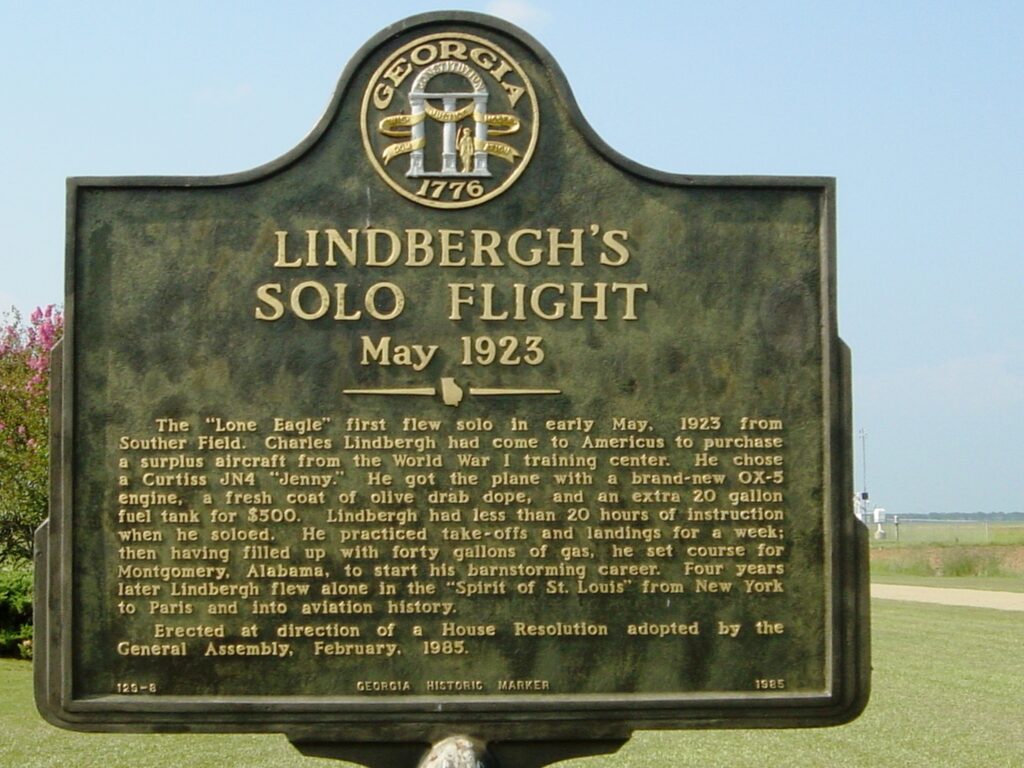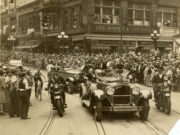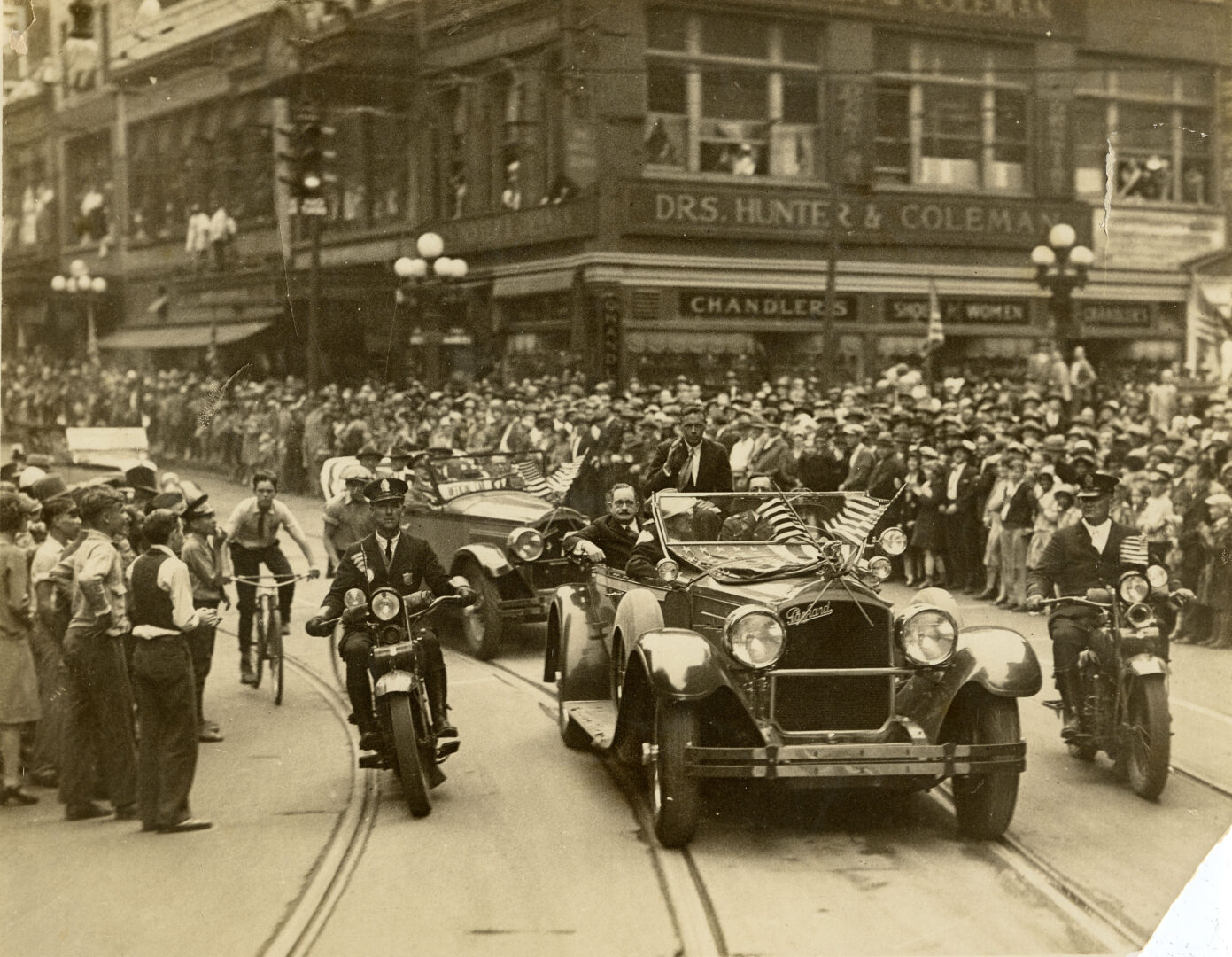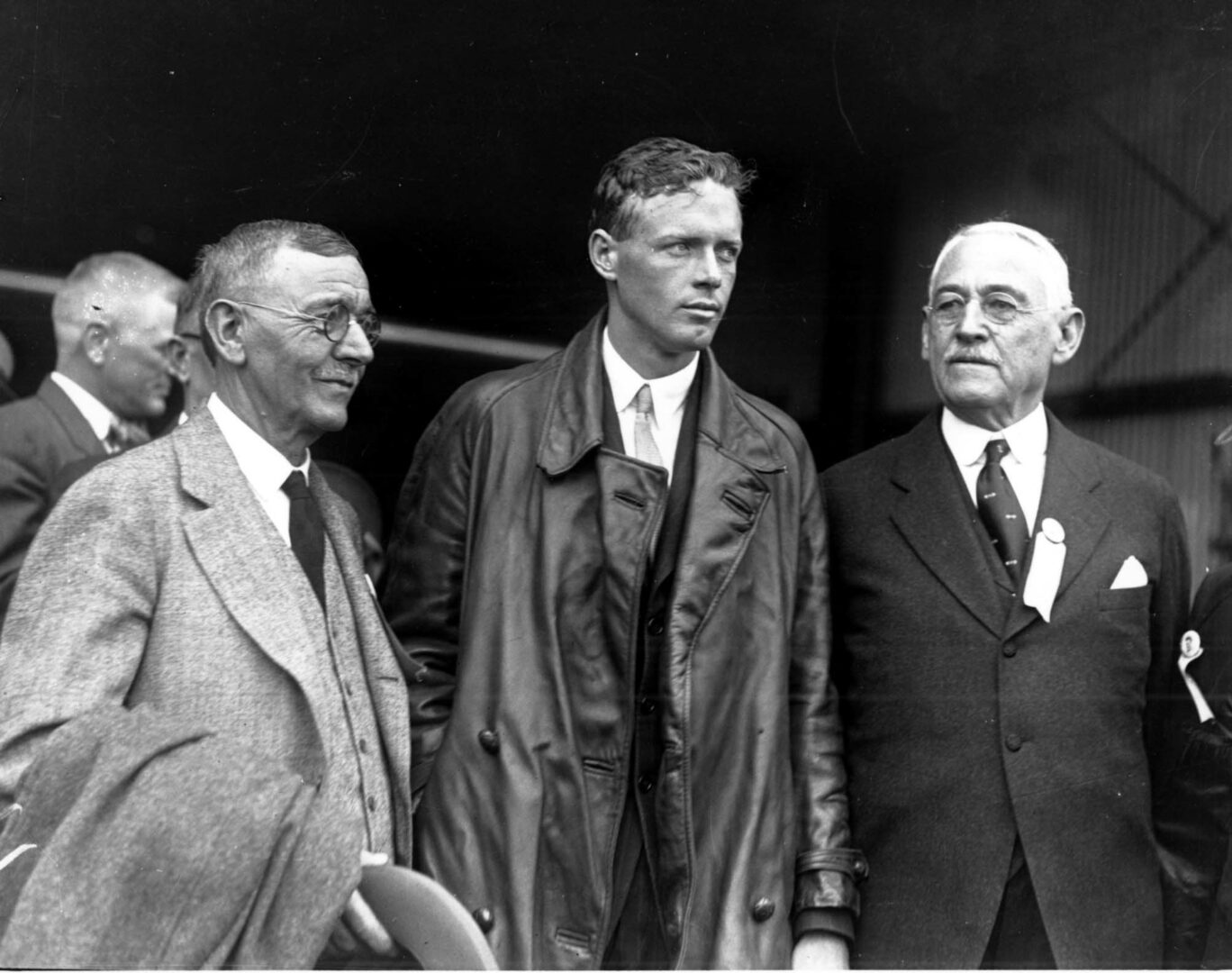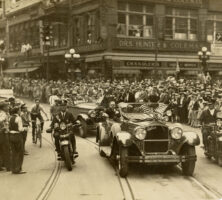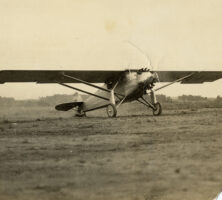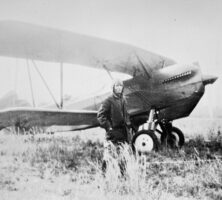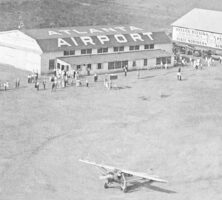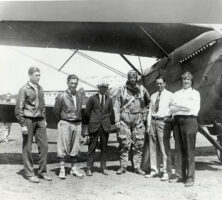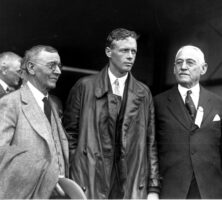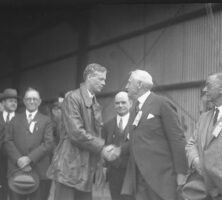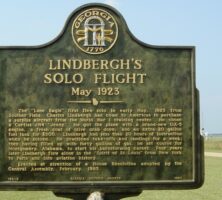In 1923 Charles Lindbergh flew his first solo flight at Souther Field in Americus. He visited Georgia again in 1927 as part of his triumphal tour in the Spirit of St. Louis, the plane in which he made his record-breaking nonstop flight between New York City and Paris, France. Lindbergh’s Atlanta visit became a stimulus for commercial aviation in Atlanta and the development of Candler Field.
Early Life
Lindbergh was born in Detroit, Michigan, in 1902 and spent his early childhood in Little Falls, Minnesota. His father, a U.S. congressman, was well known as an opponent of America’s involvement in World War I (1917-18). Lindbergh graduated from high school in 1918 and later enrolled in the engineering program at the University of Wisconsin. Neglectful of his studies, Lindbergh flunked out midway through his second year.
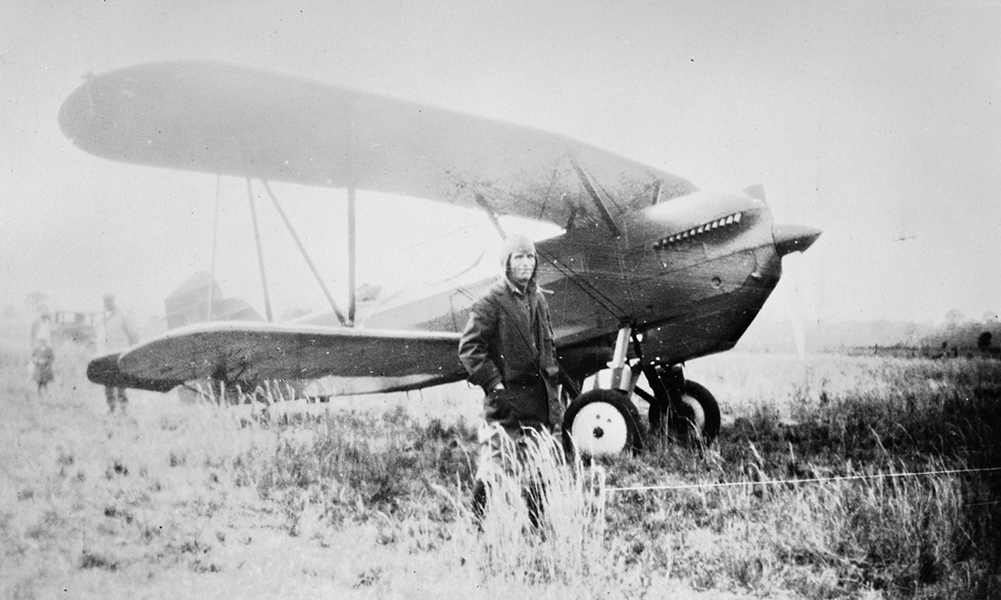
In April 1922 he enrolled in flight school and began flying lessons in Lincoln, Nebraska, though he never flew solo (without an instructor). In the summer and fall of 1922 he worked as an assistant to a Nebraska stunt pilot during the “barnstorming” season. Barnstorming was akin to an aerial circus—pilots “stormed” a rural community, dropped leaflets announcing a show, and then performed acrobatic stunts to stir the crowd’s interest. They made their money by giving rides, usually at $5 for five minutes. Lindbergh played the daredevil role, walking the plane’s wing and then jumping with a parachute.
Souther Field
In late April 1923 Lindbergh traveled to Souther Field in Americus, where John Wyche of Macon was selling surplus Curtiss JN-4 “Jenny” biplanes still in their crates. (Souther Field was a pilot training facility for the U.S. Army during WWI.) Lindbergh paid $500 for one Jenny, a Curtiss OX-5 engine, an extra twenty-gallon gas tank, and a fresh coat of olive drab dope. At night he slept in one of the vacant hangars on the deserted field; the last of the U.S. Army personnel had departed before Lindbergh’s arrival.
His plane was assembled a week later. Though not a pilot (but only he knew that), Lindbergh strapped in, started the engine, throttled forward into the open grass field, and lifted off. The day was windy, and as the plane ascended, its right wing dipped. Sensing he was about to lose control, Lindbergh brought the plane back to earth, grazing the right wing-skid. Lindbergh taxied his Jenny back to the hangar, where a pilot who had been watching offered to take him back up. They executed numerous take-offs and landings together. (There is some dispute over the identity of the pilot. Lindbergh identified him as “Henderson” in his 1927 autobiography, though in recent times Glenn Messer claimed it was he who flew with Lindbergh.)
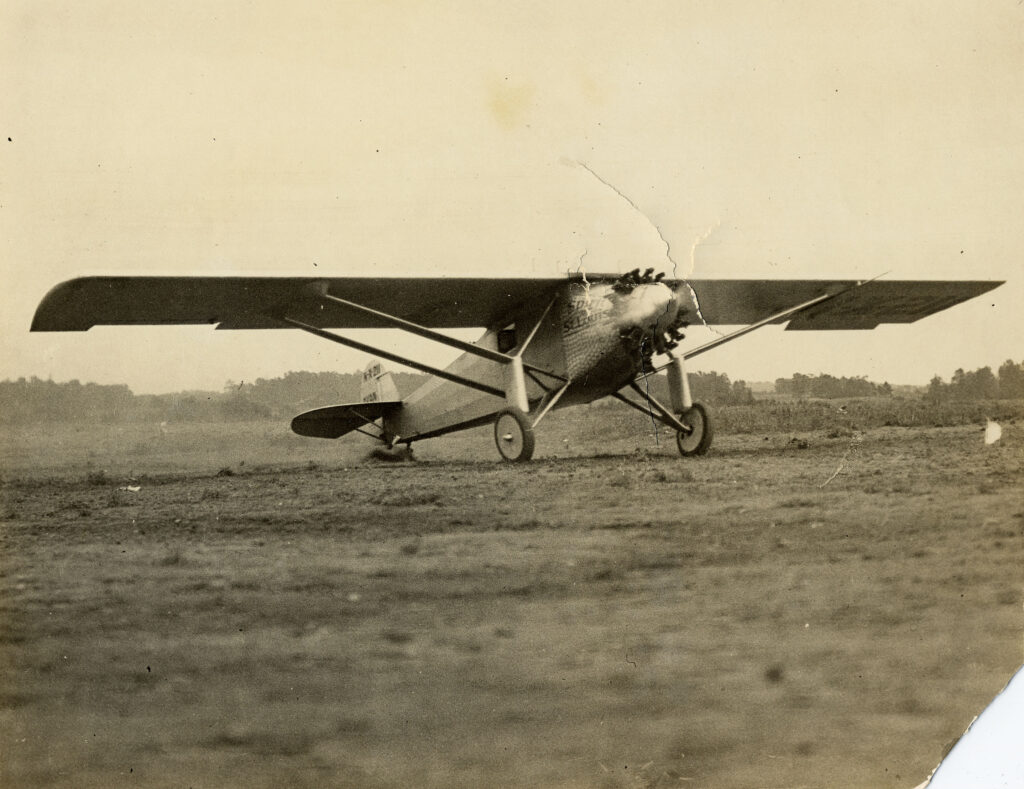
Later that afternoon, with the winds calmer, Lindbergh lifted off easily and climbed to 4,500 feet, where he looked down on the town of Americus. Later he recalled the elation of flying alone for the first time, the sound of the wind, and the far horizons of southwest Georgia visible wherever he looked. After landing, he was congratulated by a lone African American man, the only witness to Lindbergh’s solo flight.
For the next few weeks Lindbergh continued to practice take-offs and landings until he perfected his technique. Ready to set out on his own, Lindbergh decided to head home by way of Alabama, Mississippi, and Texas, where he would barnstorm. On the morning of May 17 Lindbergh rolled up his belongings in his blanket, strapped into the backseat of his Jenny, and departed Souther Field for a future that nobody could have foretold.
The Transatlantic Flight
Lindbergh gained experience as an army air reserve cadet in 1924-25 and as a pilot flying the U.S. Mails in 1926. Inspired by Raymond Orteig’s offer of a $25,000 prize for a New York-to-Paris nonstop flight, Lindbergh began preparations in 1926. On the morning of May 20, 1927, in a specially constructed Ryan monoplane that he helped design and named the Spirit of St. Louis. Lindbergh took off from Roosevelt Field in New York and thirty-three and a half hours later landed at Le Bourget Field near Paris. As he taxied to a stop in darkness, he was unprepared for the throngs that greeted him. The “Lone Eagle” was an international hero.
“Lindbergh Day”
Upon Lindbergh’s return to the United States in 1927, U.S. president Calvin Coolidge awarded him the first Distinguished Flying Cross. Immediately after, Lindbergh embarked on a forty-eight-state tour in the Spirit of St. Louis. Largely through the efforts of Atlanta city alderman William B. Hartsfield (a pilot and aviation enthusiast), Lindbergh returned to Georgia on October 11. Flying from Jacksonville, Florida, via McRae, Vidalia, and Millen, the Spirit of St. Louis landed at Candler Field in Hapeville at two o’clock on a drizzly afternoon. He was greeted by a large crowd undeterred by the weather. Atlanta mayor Isaac N. Ragsdale and Georgia governor Lamartine Hardman offered an official welcome.
Lindbergh’s entourage proceeded from the airport to the intersection of Whitehall and Forsyth streets in downtown Atlanta, where his parade formed. Meandering along West Peachtree and Peachtree streets, then turning on North Avenue toward the Georgia Institute of Technology, the parade route was lined with thousands of cheering spectators. Another 20,000 people gave him a hero’s welcome at Georgia Tech’s Grant Field, where Lindbergh called on Atlanta to recognize the commercial potential of aviation. This was a visionary message, as many in the nation still viewed aviation as dangerous (as indeed Lindbergh’s transatlantic flight was).
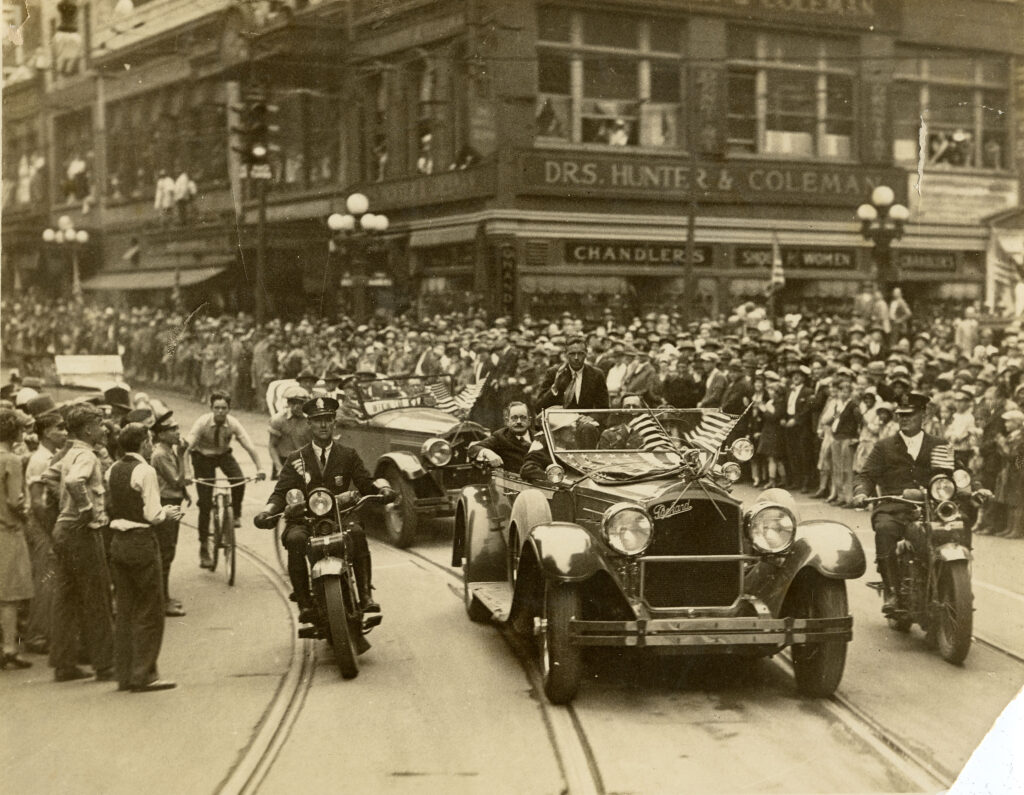
The event was the largest public gathering in Atlanta’s history, until the premiere of Gone With the Wind in 1939.
The city hosted a dinner in Lindbergh’s honor at the Ansley Hotel. At nine o’clock the next morning he arrived at Candler Field, donned his flying garb and departed for Spartanburg, South Carolina, his next stop.
Atlanta Legacy
The city’s (and the world’s) spontaneous outpouring for Lindbergh pointed to an awakening enthusiasm for aviation. Certainly Lindbergh’s presence in Atlanta strengthened the hand of local business and government leaders who saw the potential in commercial aviation. With Alderman Hartsfield’s recommendation, the city council installed a new, and expensive, electrical lighting system at Candler Field (today Hartsfield-Jackson Atlanta International Airport) at the end of 1927. This improvement made it possible for Atlanta to win designation as a U.S. Air Mail stop on the important Chicago and New York routes to Miami (beating out Birmingham, Alabama, whose officials lobbied hard for the prize). The city solidified this advantage in 1929 by converting its lease to a purchase of the airport land. In 1930 two fledgling commercial passenger carriers, Delta Air Corporation (later Delta Air Lines) and Eastern Air Transport (later Eastern Air Lines), began service at Candler Field. In three short years Atlanta’s future dominance as the commercial aviation hub of the South was assured.
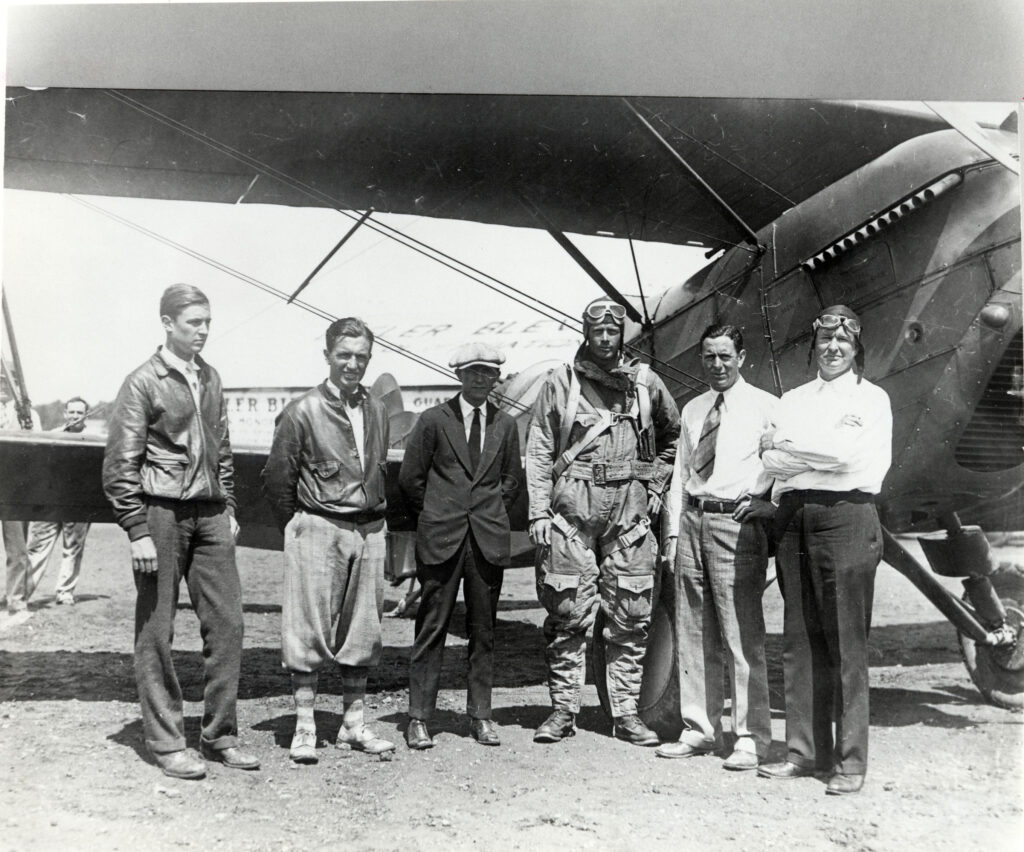
Later Life
In 1929 Lindbergh married Anne Spencer Morrow. In 1932 their baby was kidnapped and later found dead. Bruno Richard Hauptmann was tried and convicted for the “crime of the century.” Through the 1930s Lindbergh dedicated himself to the cause of commercial aviation. He also promoted rocketry and made significant contributions to cardiology.
Lindbergh’s image was badly tarnished in the late 1930s when, after making numerous trips to Germany, he spoke admiringly of Adolf Hitler’s Germany, accepted the Service Cross of the German Eagle from Nazi high official Hermann Goering in 1938, and helped lead the “America First” campaign in opposition to the nation’s voluntary entry into World War II (1941-45). During this period he also made anti-Semitic utterances.
After the Japanese attack on Pearl Harbor on December 7, 1941, Lindbergh (who earlier resigned his commission in the army reserve) attempted to enlist in the armed forces but U.S. president Franklin Roosevelt blocked his request. Still, during the war Lindbergh found ways of using his aviation expertise to benefit the American war effort.
With the war’s conclusion, Lindbergh turned to his writing, consulting, and traveling. In 1954 he received the Pulitzer Prize for his autobiography, The Spirit of St. Louis. In the 1960s he became impassioned about conservation, both wildlife and natural. He died in 1974 on the Hawaiian island of Maui, where he also chose to be buried.
Commemoration
In 1978 Griffin Bell, an Americus native, presented a memorial plaque to Souther Field Airport to commemorate Lindbergh’s solo flight. In 1992 a seven-foot bronze statue of Lindbergh, made by University of Georgia art professor and sculptor William J. Thompson, was dedicated. The statue, commissioned by the Sumter County Historic Preservation Society, stands at Souther Field as part of the airport’s Lindbergh Monument. Americus celebrated “Lindbergh Days” in 1985 with a public festival and the installation of a state historical marker. Atlanta celebrated “Lindbergh Day” in October 1987, the sixtieth anniversary of his visit to that city. Lindbergh’s original Jenny biplane is on display at the Cradle of Aviation Museum in Nassau County, New York. A permanent Lindbergh display is housed in the Griffin B. Bell Aerospace Technology Center at South Georgia Technical College.
